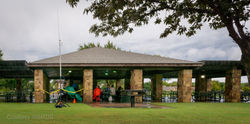

Metrocrest Amateur Radio Society

Archives
Updated November 20, 2018

A Soggy Saturday
Despite the weather, we had a good turnout for October’s Play Day-Fall Field Day-EmComm Demo event. Some suspect the lure of food was a prime motivation. David Gilpin, K5GIL, was Chef and delivered gourmet HAMburgers and COAXes-on-a-Bun.
Steve Darrah, KD5YPB, set up an APRS station and his two IP-based video cameras connected to an AREDN mesh. Carrollton Fire Chief Gregg Salmi and Emergency Management Coordinator Elliott Reep, K5EJR, were on hand to see Steve and Mike Brown, W5MDB, demonstrate the remote high-definition cameras and Winlink e-mail.
Mike and Liz Brown, K5EMB, brought their mobile go boxes to set up a Winlink station and an AREDN node. Kevin Grantham, N5KRG, braved the downpour to put up an HF vertical for his DC-to-Daylight mobile kit. He demonstrated his radio-in-an-ammo-can as well.
Always the Elmers, Kevin and David helped set up some AREDN nodes for James Jernigan, KG5WVL, and Darrell DeVault, KE5SAB. Darrell also brought his radio neatly packaged in a tool kit—complete with tools, of course.
Throughout the deluge, everything kept working. City officials noted the bad weather, but Liz pointed out, “Many emergencies take place in exactly this kind of weather, and we are prepared.”
As with all such field exercises, we learn something new every time. Mike said, “I discovered not all my gear was waterproof!”
Many thanks go to Steve for organizing this special event and thanks to all who came to play. Please click the gallery below for photos and more information.
 MARS QTH at Mary Heads Carter Park. |  Chef K5GIL consulting with K5EMB. |  Load your plate |
|---|---|---|
 Adapters |  Chips and Chili |  Chef K5GIL stirring up the flavor. |
 Kevin Grantham rolls out his coax. |  Kevin Grantham, N5KRG, braves the downpour and puts up his vertical. |  HAM stick tuned to the weather frequency. |
 Go boxes and the feed from an IP camera on the AREDN mesh. |  Carrollton Fire Chief Gregg Salmi, Carrollton Emergency Management Coordinator Elliott Reep, K5EJR, listen while Steve Darrah, KD5YPB, explains the intricacies of AREDN mesh. |  And it kept on raining. |
 Out in the weather is W5MDB's J-pole and AREDN mesh node. |  Impromptu cover for W5MDB's AREDN access point. |  With Dave Lane, N5GDL, looking on, Elliott Reep, K5EJR, “loads his plate” assisted by Chef David Gilpin, K5GIL. |
 Kevin, N5KRG, and Daryl DeVault, KE5SAB, set up AREDN firmware. |  Steve KD5YPB, showing off his remote cameras to Seth Bruce, AF5YN, and Annie Ackors-Bruce, KG5OUV. |  Dennis Duck, KF5FRT, Gary Lund, KA0LAH, Kevin Grantham, N5KRG, and James Jernigan, KG5WVL, set up an AREDN node. |
 Dale Finley, KB5NFT, Daryl DeVault, KE5SAB, and Randy Morton, KE5EOT, working on their go kits. |  When all else is under water, Hams stay dry. |  These visitors agreed Fall Field Day was all it was quacked up to be. |
President’s Corner
October 2018
It’s been a soggy month—flooding in Carrollton and Farmers Branch, hail, rain. But we were not activated. Wonder why?
The role of Amateur Radio in emergency communications is changing. True, recent events in Puerto Rico and Florida demonstrated the utility and flexibility of amateur radio HF and VHF data and voice communications, but Hurricane Harvey showed how much can be accomplished without amateur radio when the mobile infrastructure is sufficiently hardened.
Some people say this is the end of amateur radio—we’re just not needed any longer. Other, wiser heads understand what amateur radio can bring to the disaster.
What’s really happening? The various government and non-government organizations are making investments in communications infrastructure. They are making mobile “cell” towers waterproof and with sufficient reserve power to stay on the air longer. They have allocated an entire LTE data band to disaster responders and use Voice over IP (VoIP) on their dedicated bandwidth to get call calls and messages through specially-programmed mobile devices. They have created new interoperability channels and modes, and more and more agencies are adopting them.
Musings from the Vice President
October 2018
For this article I am going to take off my MARS VP name badge and put on my ARES®/RACES ID. Oops, I better put it back in my pocket. You’ll see why in a little bit. This last week I attended the AUXCOMM course in Denton put on by Homeland Security as part of the Incident Command System (ICS). As it implies, AUXCOMM provides auxiliary communications during an emergency. This can consist of operating ham radio, data links, GMRS, FRS, public service radios, etc. They also provide support for the EOC’s dispatch centers, program some or all radios, or help setup and maintain repeaters. Qualified AUXCOMM personnel can be used as dispatchers on public service radios and responsible for documenting all radio and telephone messages. These are known as RADOS. This all happens under the ICS system.
Some other positions in communications are the COML. The Communications Unit Leader heads the Communications Unit and is responsible for integrating communications and ensuring that operations are supported by communications. The COML must understand ICS and local response systems to support the efforts of Incident personnel. The COML can or cannot be amateur radio licensed.
Two Go Boxes To Go
Liz Brown, K5EMB, and Mike Brown, W5MDB, prepped for mobile comms by building HF and VHF/UHF go boxes. To read all about it, go now to download the complete article.
